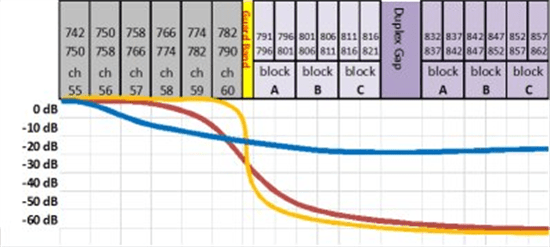LTE FAQ
Long Term Evolution for 4G and 5G in the UK
How it affects the UK Digital Terrestrial Network
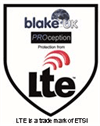
Q - What is Long Term Evolution (LTE)?
Q - What is the problem?
Q - When did it start?
Q - What is the Government Support Initiative?
Q - How will it affect me?
Q - How do I Mitigate the Problem?
What is Long Term Evolution (LTE)?
Long Term Evolution is the new protocol standard for all 4G and 5G phone systems and, as its name suggests, will be updated over time as new facilities are standardised. As a protocol standard, it is not frequency-dependent and will eventually be used on all mobile phone allocations. The major difference between 2 and 3G is that it is totally digital, i.e. voice text and data are treated the same.
The DSO process has released frequencies that can be used for other services. Fourth Generation (4G) mobile services give fast, mobile broadband. While the Fifth Generation (5G) is even faster. Tech mobile companies are promising a lot from 5G. While 4G tops out at a theoretical 100 megabits per second (Mbps), 5G tops out at 10 gigabits per second (Gbps).
The World Radio Communication Conference in 2007 allocated parts of TV bands IV & V for mobile applications. 791 – 862MHz were allocated for UK for 4G and 703 - 791MHz for 5G. These are the frequencies that are relevant to the current DTT network.
In addition, there are bands at 1.4, 1.8, 1.9, 2.1, 2.3 and 3.4GHz. (Please note you can review our Wi-Fi & 4G aerials guide. The frequencies made available by the switch to digital transmissions have been sold to give revenue for the government – the ‘Digital Dividend’. The government is also committed to faster broadband for greater numbers of people.
UK smartphone growth figures and why there is a demand for faster mobile broadband.
4G and 5G require much higher power base stations and a supply a large range of mobile devices.

4G and 5G offer rural broadband solutions in areas where a cabled solution from BT Openreach™ or other providers is not always practicable.
Pre-LTE Frequency Band Plan
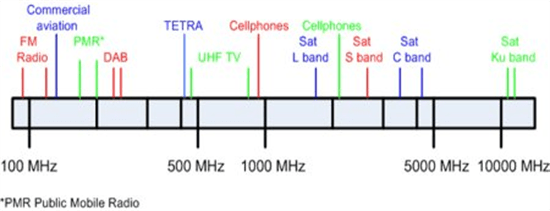
For both 4G and 5G, the mobile equipment base stations use different frequency blocks between the LTE base station and the mobile equipment.
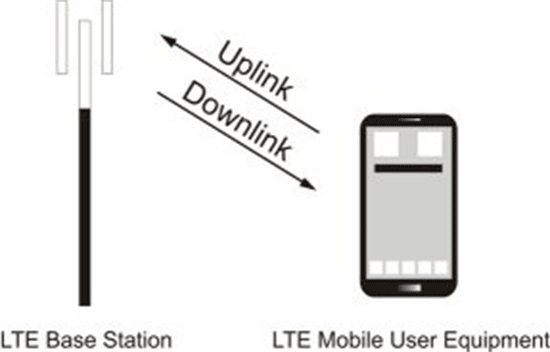
4G - LTE 800 Effects on the UHF TV Spectrum
LTE is split into separate paired blocks A, B & C. With different licensed operators in each block.

PMSE – Programme Making & Special Events
Downlink blocks 791- 821MHz. Uplink blocks 832 – 862MHz.
Note for 4G it is the downlink blocks that are the closest to the DTT spectrum.
The guard interval between DDT and the LTE is only 1MHz.
5G - LTE 700 Effects on the UHF TV Spectrum
LTE is split into separate paired blocks A, B & C. With different licensed operators in each block.

PMSE - Programme Making & Special Events
Uplink blocks 703- 733MHz. Downlink blocks 758 – 788 MHz. (paired spectrum)
With an additional downlink (System Link Block) 738 - 758MHz
Note for 5G it is the uplink blocks that are the closest to the DTT spectrum.
The guard interval between DDT and the LTE is 9MHz but available for PMSE.
The actual network of LTE transmitters will be in addition to the current services. This will be a dense network of transmitters.
LTE for 4G and 5G uses a network topology similar to existing 2G and 3G networks and requires up to 18,000 main sites.


The main issue is the proximity of the LTE transmissions to the current DTT network and the levels of power that will be used.
Interference ingress to DTT reception from LTE can occur in all parts of the system from the aerial, amplifiers, cabling, outlet plates and fly leads and can overload a system.
LTE Consumer mobile devices operating in the proximity of existing TVs could interfere via the Uplink Blocks if there is poorly screened equipment in the system.
Symptoms for those affected might include a loss of sound, pixelated images or even the loss of all channels and are more likely to affect viewers who are close to an LTE transmission mast.
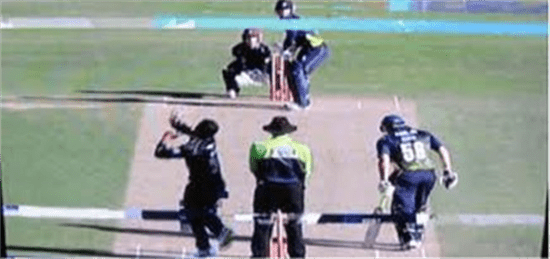
Above picture is a sample of LTE interference.
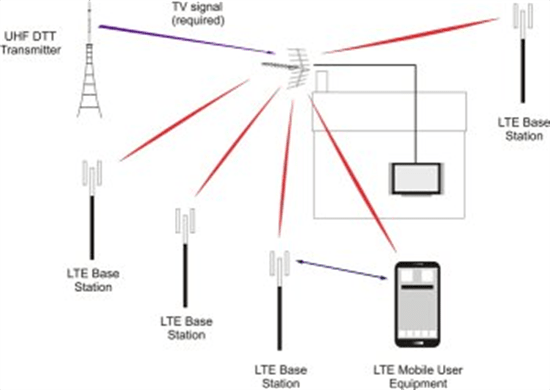
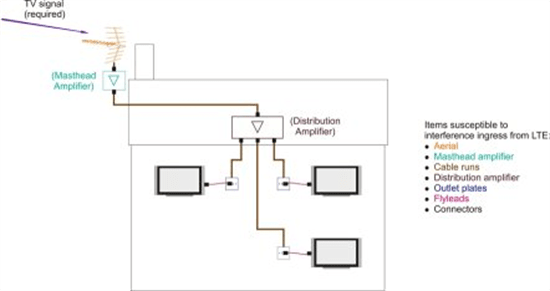
When did it start?
The roll-out to cover Britain’s major conurbation areas started in 2012 for 4G and took a number of years to complete. 5G started in late 2019, and the rollout of transmitter changes to the DTT signal to allow the increase of LTE 5G coverage will continue over the next couple of years.
Interference will increase as the rollout of the transmitters gains pace, and there are more users on the networks, as shown below.
- Idle mode interference to some 6-10% of TV sets
- As mobile sales increase, proximity interference to TVs will increase.
- Deployment of “fill in” Pico and Femto Cells may invalidate previous mitigation, require extra work, and cost the user.
- Interference will increase as more LTE transmitters are installed, noise floor increases, and more devices become active using the 4G and 5G networks.
Government Support Initiative.
|
The mobile operators were required to set up DMSL - Digital Mobile Spectrum Limited (originally called MitCo) as part of the auction process to action LTE-related interference problems. Initially £180 million has been reserved from the auction fees to liaise with consumers and deal with any interference problems. The scheme offers a single free filter to correct LTE inference for TVs where the DTT platform forms the primary viewing. Costs for secondary sets needing filters will need to be covered by the homeowner. In certain cases, where a particular TV system cannot be cured by filtering, then Freeview™ can be replaced with another platform (Freesat™, Cable, Internet, etc) Many consumers trust the local installer who is in many cases the first port of call. For 5G, most Freeview viewers will simply need to retune their TV equipment when this change occurs in their area. However, Ofcom has stated that between 140,000 and 270,000 homes may need to replace or realign their aerial to continue receiving all available channels. Ofcom states that as part of 700MHz clearance:
|
|
How will it affect me?
For most consumers, it will just mean a series of re-tune events during the rollouts. Some consumers may wish to have a professional installer perform the re-tune, but most should be trouble-free.
In some cases, the move of channels means that the aerial and distribution equipment may need replacing and upgrading.
New Aerial Groups and CAI Benchmark Standards
The DTT Groups are shown below.
For 4G roll out the groups C⁄D and WB were superseded.
For 5G roll out groups B and T will be superseded leaving Groups A and K.
Consideration for LTE must be made when installing products:
- Ensure there are no unhappy customers with interference on their TV(s), caused by an unreliable DTT signal.
- LTE interference will be well publicised, but many people will not notice until the TV signal becomes a problem.
- Installations before LTE without filtering also need to be considered.
- Possible > 2 million households affected for both 4G and 5G
- Opportunity to increase business post DSO.
- Retro-fit existing installation with LTE filters, good cable, fly leads, outlet plates etc.
For new installations consider correct choice of:
- Aerial. For 4G mitigation, choose group T rather than WB. WB is only applicable where there is a requirement for good reception on channel 60. In these cases a separate LTE filter may be required. It is recommended that you choose a CAI-certified benchmarked aerial in all cases.
- Splitter / Amplifier. In some cases, the increase of power of the DTT signals means that the amplifier may be replaced with passive splitters.
- Cable. It is recommended that you choose a CAI-certified benchmarked cable in all cases.
- Outlet Plate/Fly lead. Fully screened products are needed to prevent the ingress of unwanted signals.
- Filter - Warning!! - Filters have a loss, and Filters fitted by the general public may affect their TV reception. Allow for filter loss in your signal budget.
Need to consider the correct use of filters
|
Red Filter Passes channel 58 with 3dB of insertion loss 45dB rejection of LTE A. Yellow Filter
Higher cost to pass 59/60 & reject LTE A Blue Filter
Traditional Filter Design (Not Suitable) |
|
How do I Mitigate the Problem?
Prepare for a change in your communication, marketing and installation techniques:
- Consider your relationship with your customer.
- Educate them to the possible issues.
- Sell the preventative measures.
- Review your terms and conditions of sale. Ensuring that you cover yourself so changes in the transmissions which could effect your installations are outside any warranty.
- Consuder in extreme cases possible change to alternative platform (Freesat™, Cable, Internet, etc)
Mitigating the Problem. - Consider the following that may reduce the interference:
- Fit LTE Filter between the aerial and the amplifier, distribution system or TV. (Whichever is first in the chain)
- Consider removing and replacing unscreened / poorly screened components such as cable, flyleads & outlet plates.
- Removal of High Gain Unscreened Mastheads.
- Integral Aerial Amplifiers in the Dipole are unlikely to have the correct filtering. (Can not filter before the amplifier).
- Fit additional filters in the system where necessary.
- Relocating coax to use the building to shield from the interference, placing the coax run down the other side of the house.
- Positioning the aerial to use the chimney stack as a shield sometimes requiring the aerial to be re-aligned on a different transmitter.
Mitigating the Problem. - What to fit:
- Consider the “system” as a whole when preventing LTE ingress. All parts will contribute to a successful installation.
- Fit LTE Filter between the aerial and the amplifier, distribution system or TV. (Whichever is first in the chain)
- Aerial. Fit CAI-certified benchmarked product.
- Masthead Splitter, Amplifier and Distribution Amplifiers MUST be fully screened products, and to maintain RED compliance where the product is amplified, you MUST fit an approved product. See RED Compliance.
- Cable. Fit CAI-certified benchmarked product.
- Outlet plates and flyleads only fit fully screened products.
Mitigating the Problem -Aerials:
The CAI certified aerial scheme has been designed to take account of all the relevant parameters to provide a passive reduction of the unwanted LTE signals whilst maintaining good performance in the wanted DDT signals. These designs are designated group T. The CAI are considering new certification standards for 5G - Group K performance in 2020.
Forward Gain:
- Increased transmitter power for DTT signals means lower gain aerials may be used.
- Consider the Out of band performance as important (Traditional Designs of Yagi v Log).
- Gain is only needed for channels 21-60 Gain for the LTE blocks will only cause additional problems, so fit Group T aerials instead of WB.
Polar Plot:
- Consider any nulls in the reception.
- Response changes with frequency.
Cross Polar Rejection:
- LTE is vertically polarised. For horizontal installation, this gives at least 16 dB of rejection to the LTE signal.
Mitigating the Problem: Aerials - Location of the Aerial in relation to local LTE Base Station:
- Consider location of the aerial. Can it be re-sited in the same building but using the building, surroundings, or local topology as a screen?
- Aerials mounted high on the chimney will be better versus a lower gable end installation.
Use the correct aerial Group - A, B, K, T for 4G and A, B or K for 5G
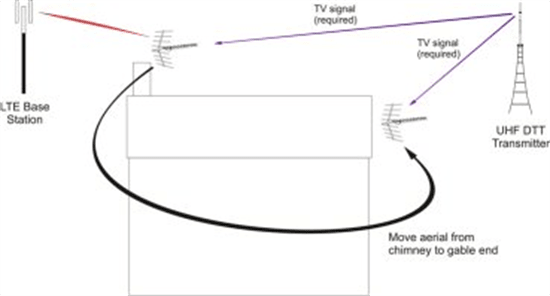
Mitigating the Problem: Aerials - Change of the Aerial Group in relation to local LTE Base Station:
- With increased powers from TV transmitters, consider if there are alternative transmitters from which to receive the DTT signals. Redirection and repositioning of the aerial may reduce the LTE interference. Fitting an aerial to receive DTT signals from a distant alternative transmitter may now be possible.
- If the alternative transmitter uses lower channel frequencies such as a group A or B then the level of attenuation required by the filter will be reduced.
- NB: Where viewers have to change the region with the new transmitter, this can cause customer dissatisfaction.
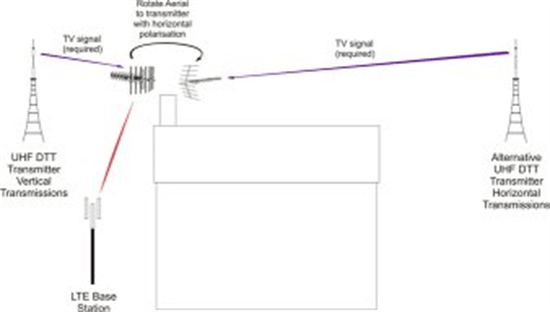
Mitigating the Problem: Aerials - Change of the Aerial Polarity in relation to Local LTE Base Station:
- If the LTE base transmissions are vertical only. If possible, choose a horizontal transmission.
- Fitting an aerial to receive DTT signals from a distant alternative transmitter may now be possible.
- The cross-polar protection from the aerial will assist with the Vertical LTE interference.
- NB: Where viewers have to change the region with the new transmitter, this can cause customer dissatisfaction.
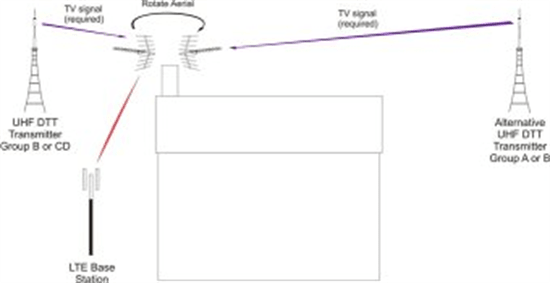
Mitigating the Problem: Filter for 4G
High attenuation of the LTE bands will cure the majority of interference problems from both base stations and mobile user equipment.
For 4G we offer a range of other filters that cover application for channels 57. Four models are available proLTE1-57C, proLTE1-57F, proLTE1-57FLY
- Pass all terrestrial broadcast transmissions up to and including TV channel 57.
- High attenuation in LTE bands. Will cure the majority of interference problems from both base stations and mobile user equipment with 35dB-55dB rejection.
- Low insertion loss and good 75Ω match throughout the pass-band.
- Choice of either IEC or F-type connectors with good screening, helping prevent leakage around the filter.
- Male and female connectors allow insertion into existing systems without further cables or back-to-back adapters.
- Power-pass: this is a pure low-pass filter and passes AC and DC line power.
- Inline Versions have waterproof housing, suitable for outdoor applications when used with suitable mating F connectors. (Rated to IP55).
- The Fly lead version is ideal for fitting at the back of a low-profile TV or in difficult access areas.
- All have Power pass rating 24V and 250mA max.
Mitigating the Problem: Filter for 5G:
High attenuation of the LTE bands will cure the majority of interference problems from both base stations and mobile user equipment.
We also offer a range of other filters that cover application for channels 48. The inline model is a 5G & 4G Filter with F female and F male PROLTE5G700
- Pass all terrestrial broadcast transmissions up to and including TV channel 48
- High attenuation in LTE bands. Will cure the majority of interference problems from both base stations and mobile user equipment with 25dB rejection.
- Low insertion loss and good 75Ω match throughout the pass-band.
- Male and female connectors allow insertion into existing systems with no need for further cables or back-to-back adapters.
- Power-pass: this is a pure low-pass filter and passes AC and DC line-power.
- Inline Versions have waterproof housing, suitable for outdoor applications when used with suitable mating F connectors. (Rated to IP55).
- All have Power pass rating 24V and 250mA max.
Mitigating the Problem: Filter - PROception: Splitters with LTE Blocking Filter
Two models available BLAMHS12Pand BLAMHS12P
- 2-, and 4-way models available. Pass all terrestrial broadcast transmissions up to and including TV channel 48. High attenuation in LTE bands will cure the majority of interference problems from both base stations and mobile user equipment.
- Low insertion loss with excellent 75Ω impedance matching and high isolation between outputs.
- Fully screened RF modules in robust diecast enclosures. Strong cast-in 'F' connectors. Proven free-draining moulded enclosures give easy access and cannot trap water.
- Directional power pass (20V & 250mA max) from any output leg to the common input, allowing an upstream amplifier to be powered.
- Low insertion loss and good 75Ω match throughout the pass-band.
- Male and female connectors allow insertion into existing systems without further cables or back-to-back adapters. With equipotential bonding point.
Mitigating the Problem: Filter- PROception : Overlap Blocking Filter with LTE Filtering:
Four models available proOBF1A, proOBF1B, proOBF1C and proOBF1E.
- UHF bandpass filters intended for blocking unwanted reception of transmissions from an adjacent region.
- Optimised passbands cover most UK requirements in just four versions.
- Good out-of-band rejection helps block TETRA, GSM, and LTE (4G), depending on the model. e.g. proOBF1A for CRYSTAL PALACE
- Typical stopband rejection is around 35–40dB except close to the band edges.
- Good 75Ω match throughout the passband.
Mitigating the Problem: Cable, Outlet Plates and Fly-leads:
- Fit ONLY high-quality cables. The use of CAI-certified benchmarked cables with additional high-quality screening is recommended.
- ONLY fit outlet plates that conform to the EMC standard EN50083-2.
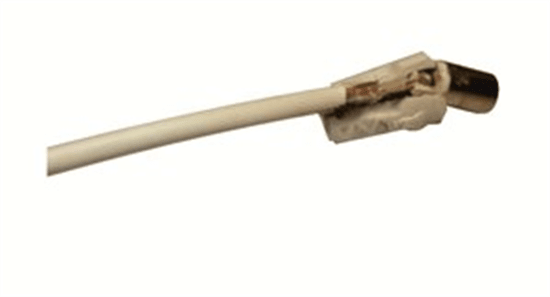
Above is a poorly screened flylead
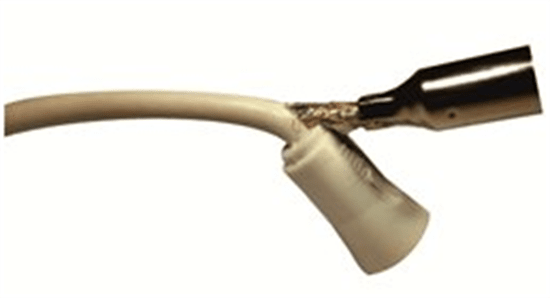
Above are screened outlets and screened flylead
Mitigating the Problem: Measurement
Use meter that can specifically analyse and identify LTE interference.
Meter Measurement of LTE.
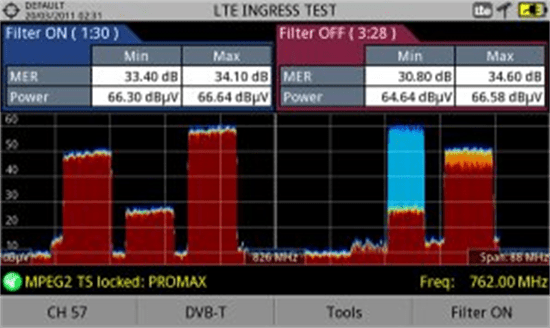








 Quick Add
Quick Add
